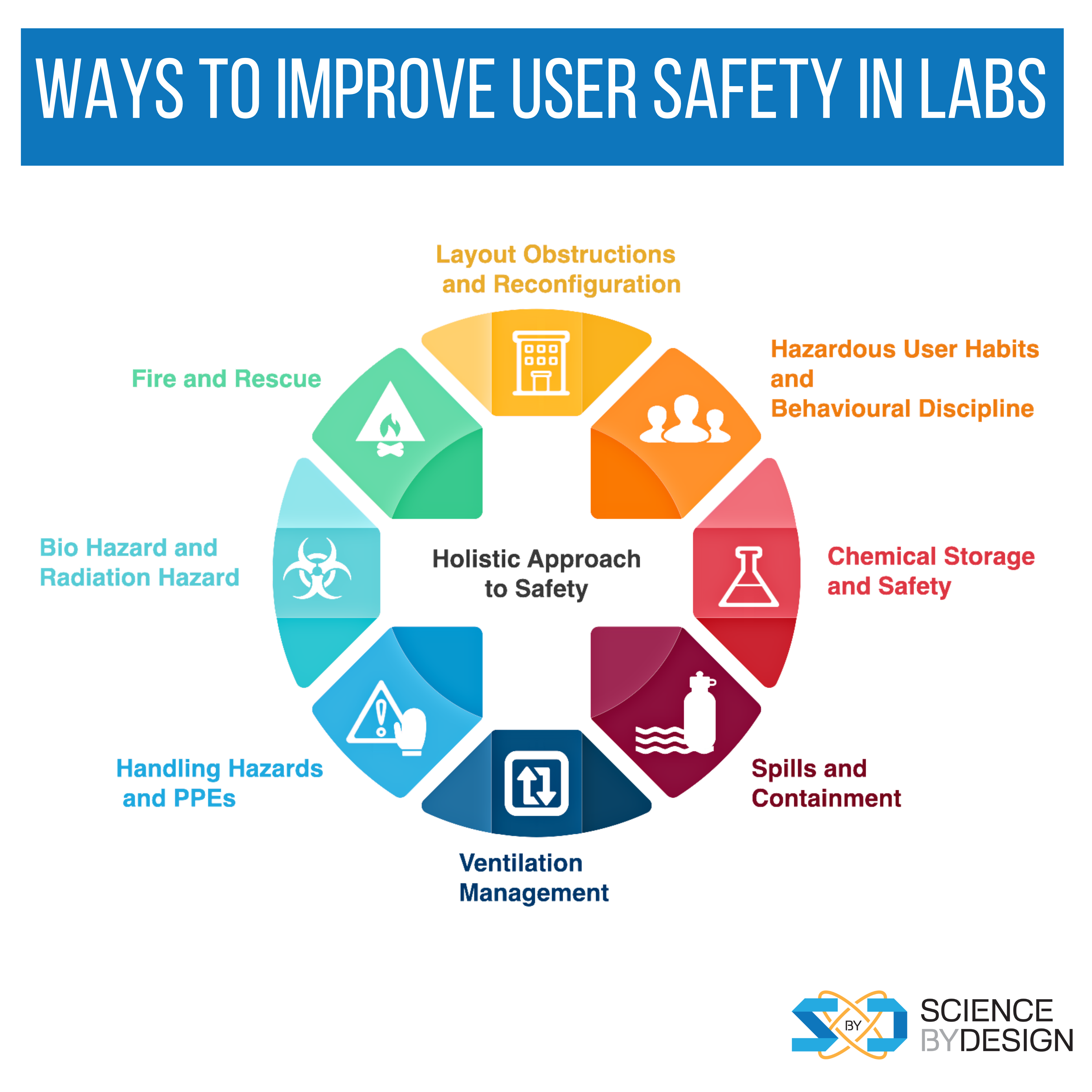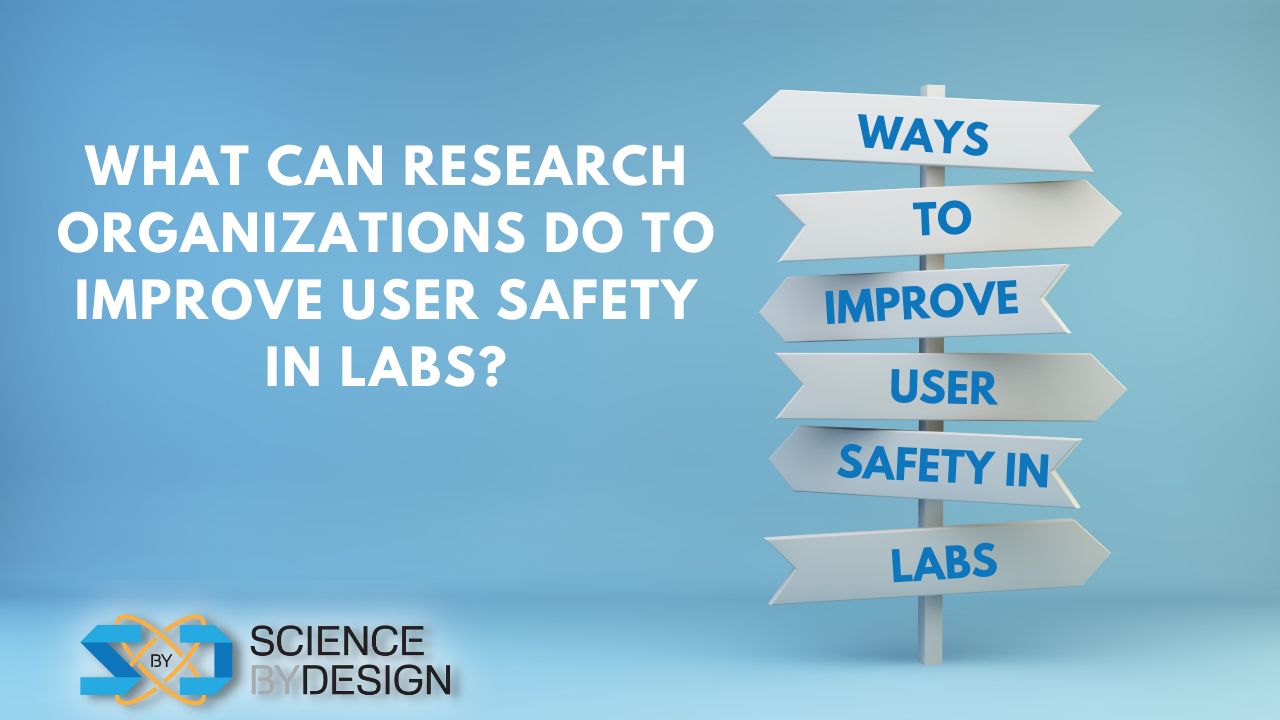Twenty-two months into the pandemic should be a good time to take a hard look at the safety measures taken in our working arena or personal sphere. As lessons learned in personal hygiene and safety are with us, it would be prudent to relook into user safety inside contemporary research facilities.
Today’s research laboratories are larger, interdisciplinary making them more complex in layouts, structure, and goals. User scientists are now surrounded by reagents, heavy instrumentation, complex ventilation systems, reconfigurable set-ups, working relentlessly to take the research forward. We probably have a lab ecosystem that is much more promising, efficient, connected, yet demands maximum attention to safety like never before. Let’s review major safety hazards in research labs and approach to deal with them.
 1. Ventilation Management
1. Ventilation Management
While fumes are the most common and most significant hazard in labs, ensuring overall good air quality is always challenging. Fumes are tackled with Ducted Fume Hoods, Ductless (recirculating) Fume Hoods, Isolators, Ducted Enclosures (built to suit), Spot Fume Extractors (Fixed and mobile), Canopy Hoods, Ventilated Storages, etc. Each of these pieces of equipment is designed for a specific use, that too with proper precautions and operating instructions. Many times, the equipment is used for an unintended purpose. Sometimes without following the correct SOP. Even expecting the equipment to borrow human intelligence and let the user take liberties with the SOP. This approach is detrimental to user safety can put the whole establishment at risk. A good approach will be to ensure continuous user training and adherence to safe working practices. A culture of safely using the equipment and paying enough attention to its limitations must be developed. Although this aspect appears to be simple and routine, non-adherence might have disastrous consequences.
Like a fighter aircraft on a critical mission, a fume ventilation device (one of the above) must always be in battle-ready condition. Meaning it must be audited/tested, calibrated, and certified at reasonable intervals. At times, one is surprised to see malfunctioning airflow monitors, corroded parts, and pent-up fumes inside the equipment. A tell-tale sign is a smelly lab. Similarly, the complex ventilation systems connecting these equipment and exhausting fumes outside need engineering maintenance and calibration regularly. Since these systems are out of sight hidden under a false ceiling (unless in open ceiling labs), they might skip the attention of users. Users aren’t aware of the technical nuances but might suffer hazards due to malfunctioning ventilation systems.
Here the role of the engineering support team is important. They have the responsibility to ensure efficient functionality, just as the ground engineering team has in handing over a perfect flying machine to a fighter pilot.
Today’s research labs are responsible not only for the user’s safety but also for the safety of the community to which they belong. They use Wet Scrubbers and/or Carbon Filters (Dry Scrubbers) to remove the traces of harmful substances, SPM and odors before releasing the fumes to the atmosphere. This equipment must be tested and certified routinely by the engineering team.
2. Handling Hazards and PPEs
Users in research laboratories should be adequately trained and equipped on the right PPEs based on their work profile. Most material handling hazards such as burns, eye injuries, spills on the body, etc. can be effectively mitigated by using the PPEs correctly. Although modern fume handling equipment does offer adequate protection, one can consider the use of Respirators (masks) as the second line of defense. A variety of Respirators for correct use with Organic/ Inorganic gases, Particulate Dust, Acids, Solvents, etc. are available from reputed manufacturers. Even Mercury vapor protective headgear and Respirators are available. There are supplied air Respirators too for demanding conditions. These must be properly selected, fit-tested, and most importantly worn all the active time. Gloves, Aprons, Head Cover, Eye Goggles must be used and be easily accessible. Needless to mention that reusable PPEs must be decontaminated before their next use.
3. Chemical Storage and Safety
Contemporary Research Labs have to stock a variety of chemicals which may pose an independent risk in storage and handling. Most of these reagents are volatile substances, some may be harsh acids, and some could even be carcinogenic. At times, novel chemical substances need to be stocked for specific experiments and may pose additional demands on storage and handling. As a non-negotiable policy, MSDS (Material Safety Data Sheets) must be available (and easily accessible) for each chemical. Flammable Chemicals need specific storages which are rated by time in minutes such as 60-90 etc. These must be stored exactly as needed and must be handled most carefully. Flammable Storage Cabinets need regular checks and proactive maintenance. Routine chemicals too deserve their marked and safe storage. The path to eye showers and safety showers must be uncluttered and marked, ensuring fast reach during an emergency.
4. Spills and containment
Some Lubricants and Viscous Fluids pose higher risks during Spills. Spill containment products such as chemical sorbent pads and pillows must be stocked, and need to be quickly accessible. Users must be trained regularly on Spills containment measures with available material. One must remember that some spills appear innocent till their effects are experienced.
5. Bio Hazard and Radiation Hazard
A separate safety program for Bio Hazardous materials (or samples) and Radioactive materials must be evolved. Safe storage and handling of these substances require specific equipment, and the users must be well trained about their safety aspects. Laminar Airflow Benches, Biological Safety Cabinets (conforming to standards) must be used as needed. User training, maintenance, and testing of this equipment are of critical importance. Here the role of PPEs is critical. For Radioactive material, separate and designated fume hoods are used. These need to be critically maintained with emphasis on specific PPEs for the user.
6. Fire and Rescue
Research Labs, by their nature, are fire-prone. Handling solvents, flammable chemicals, and rarely explosive material have the potential to initiate and propagate fire. Particulate matter, by itself, might appear harmless, but if a cloud of such matter forms, it could turn explosive. Some ducting material such as FRP might help spread the fire to other areas. In modern Research Labs, Fire Seals/ Fire Isolators are used within the ducting network. These may not be able to stop the spread of fire altogether, however, they delay such occurrences so that rescue of personnel can be ensured. An emergency evacuation program must be in place and all users must be well trained on it. Training on the correct use of Fire Extinguishers is critical, as also the refilling of extinguishers with the expiry date marked.
7. Layout obstructions and reconfiguration
A good amount of detailing is done by designers and engineers so that there is no clutter and enough evacuation spaces in modern research labs. Some layouts are even reconfigurable to some extent. This approach accommodates newer setups and new equipment. However, in existing labs sharp furniture corners, narrow spaces, clutter, and equipment density, might pose additional risks of injury and evacuation challenges. Layout changes could be made to mitigate such risks.
8. Hazardous user habits and behavioral discipline
As our society strives for newer solutions to existing and novel problems, a lot of pressure befall the research community. There is the pressure of time, process adherence, and data reporting on a scientist. She is always surrounded by complex materials, equipment, and systems. Each of these components of the Lab Ecosystem demands individual and collective attention. It is likely that under such circumstances, some critical precautions may be overlooked. Some common undesirable habits are bad housekeeping and clutter in the lab spaces, stuffing the storage below lab benches with all kinds of stuff including personal belongings, eating food in the lab, incorrect or not using PPEs, not keeping fume hood sash closed (or at safe working height), using ovens at wrong places, checking whether a fume hood is working by holding a strip of paper in it and neglecting the issue of smell in the lab are just a few. Thankfully, all such habits can be easily amended by proper training and involvement in the safety program. It is worth repeating that reorientation training at regular intervals goes a long way into inculcating safety culture among users.
9. Holistic Approach to Safety
Scientists are the greatest asset of modern research labs. They are a precious resource not only to their organization but also to the country. The safety and well-being of scientists should therefore extend outside the labs also. Refresher courses in safe driving, Safety at home, emotional wellbeing, personal health & hygiene, Wok-Life Balance, etc. may go a long way. The good part is that scientists are always open to new ideas and ready to learn something new. They have the attitude but tools must be provided by their organization. This will lead to the building of a shared safety attitude and culture in a research organization.


